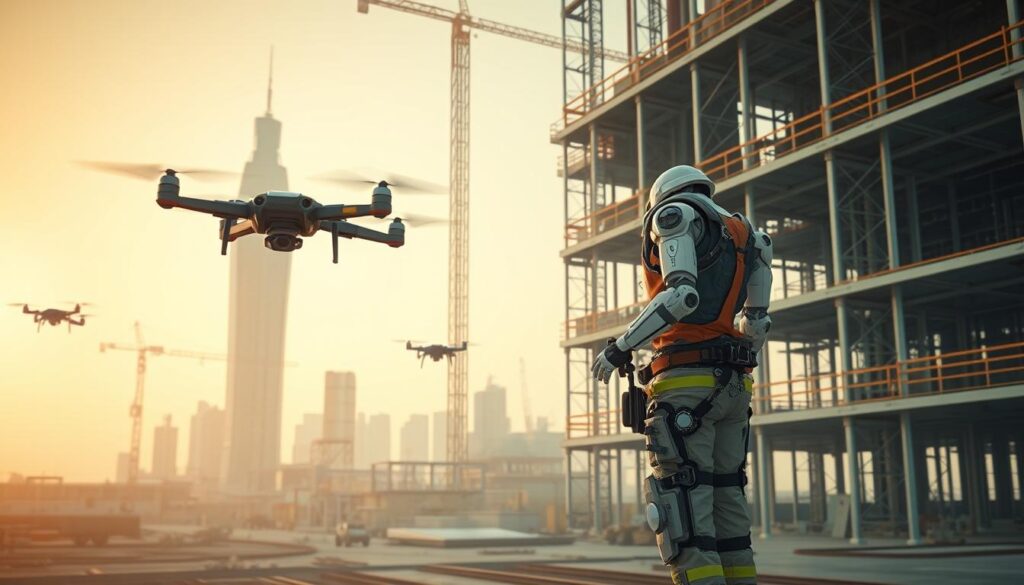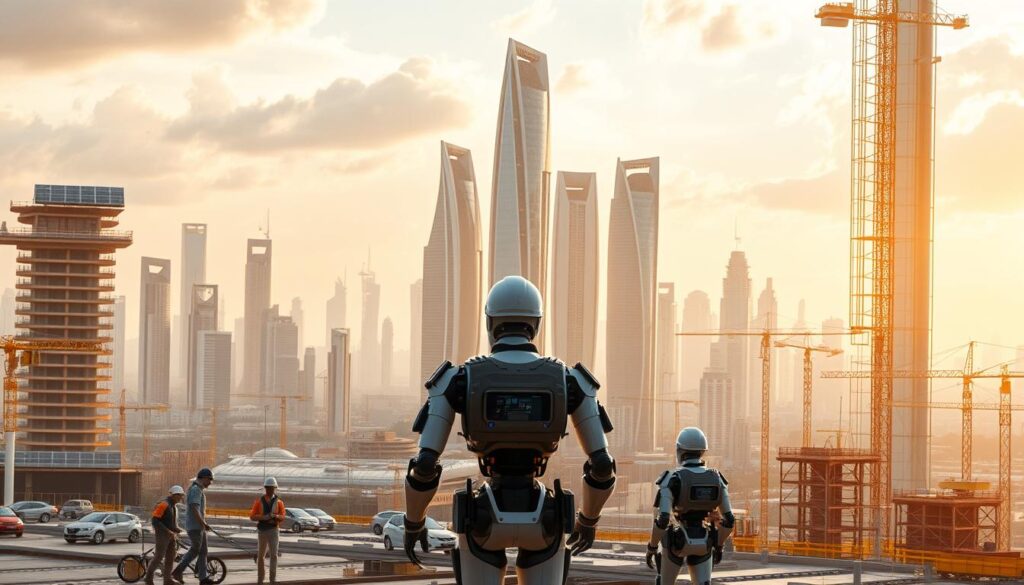The construction industry is on the cusp of a revolution, with artificial intelligence transforming the way civil engineers work. Did you know that AI can analyze complex data, predict potential issues, and optimize project outcomes, potentially saving billions of dollars in costs and reducing project timelines?
As highlighted in a recent study on how AI is transforming civil engineering, the integration of AI-driven tools is enhancing innovation, improving efficiency, and revolutionizing the built environment.
The use of AI in this field is not just a trend; it’s a necessity for staying competitive. By embracing AI, civil engineers can automate routine tasks, identify potential issues early, and develop more effective solutions, ultimately shaping a more sustainable and efficient future.
Key Takeaways
- AI enhances innovation in civil engineering projects.
- AI improves efficiency and safety in the industry.
- AI integration revolutionizes the way civil engineers work.
- AI optimizes project outcomes in the civil engineering sector.
- AI can automate routine tasks and identify potential issues early.
Introduction to AI in Civil Engineering
The integration of Artificial Intelligence (AI) in civil engineering is revolutionizing the way infrastructure projects are designed and managed. As the industry evolves, the adoption of AI technologies is becoming increasingly crucial for enhancing project outcomes.
According to David Odeh, P.E., S.E., F.SEI, F.ASCE, “AI involves the use of computers or other digital technologies to ‘replicate the function of the human brain, of human intelligence.'” This definition underscores the potential of AI to transform traditional engineering practices.
What is AI?
AI refers to the development of computer systems that can perform tasks that typically require human intelligence, such as visual perception, speech recognition, and decision-making. In the context of civil engineering, AI encompasses a range of technologies, including machine learning in construction industry and automated design technology.
Importance of AI in Modern Engineering
The importance of AI in modern engineering cannot be overstated. AI is being used to improve project planning, execution, and maintenance. For instance, AI algorithms can analyze vast amounts of data to predict potential project delays or cost overruns, enabling proactive measures to mitigate these risks.
Moreover, AI is enhancing the design process by allowing for the simulation of various scenarios, optimizing designs, and reducing the need for physical prototypes. This not only accelerates the design process but also leads to more efficient and sustainable infrastructure.
“The use of AI in civil engineering is not just about improving efficiency; it’s about creating a more sustainable and resilient infrastructure for the future.”
By embracing AI, civil engineers can unlock new possibilities for innovation and improvement, ultimately leading to better infrastructure and a more sustainable future.
Applications of AI in Civil Engineering

The integration of Artificial Intelligence (AI) in civil engineering has revolutionized the field, offering innovative solutions for complex challenges. AI’s capabilities are being harnessed across various stages of civil engineering projects, from initial planning to final execution.
Project Planning and Design
In project planning and design, AI algorithms can analyze vast amounts of data to optimize project parameters such as cost, time, and resource allocation. AI applications in urban planning enable the creation of more efficient and sustainable urban infrastructures by simulating different scenarios and predicting outcomes.
For instance, AI can help in designing roads and highways by analyzing traffic patterns, environmental impact, and other factors to determine the most effective routes. This not only improves the planning process but also enhances the overall quality of the infrastructure.
Construction Management
During the construction phase, AI can be utilized to monitor progress, manage resources, and predict potential delays or issues. AI-powered systems can analyze data from various sources, including sensors and drones, to provide real-time insights into the construction site.
This enables project managers to make informed decisions promptly, reducing the risk of costly delays and improving overall project efficiency. Moreover, AI can help in enhancing site safety by identifying potential hazards and suggesting preventive measures.
Infrastructure Monitoring
AI also plays a crucial role in the monitoring and maintenance of infrastructure. By analyzing data from sensors embedded in structures such as bridges and buildings, AI can predict when maintenance is required, reducing the risk of failures and extending the lifespan of the infrastructure.
The use of AI in infrastructure monitoring is a key component of smart infrastructure solutions, enabling proactive maintenance and ensuring the longevity and safety of critical infrastructure.
Benefits of AI in Civil Engineering
AI-driven civil engineering innovations are transforming the industry in various ways. The integration of AI technologies into civil engineering projects has led to significant advancements, making processes more streamlined and effective.
Increased Efficiency
The use of AI in civil engineering has resulted in increased efficiency across various project stages. From planning and design to construction and maintenance, AI tools help in optimizing resources and reducing timelines. For instance, AI algorithms can analyze vast amounts of data quickly, enabling engineers to make informed decisions faster.
Improved Safety
AI contributes to improved safety in civil engineering by predicting potential hazards and suggesting preventive measures. AI-powered monitoring systems can detect anomalies in infrastructure, allowing for timely interventions. This proactive approach to safety is crucial in preventing accidents and ensuring the well-being of both the workforce and the public.
According to a recent article on what civil engineers need to know about artificial, the adoption of AI is becoming increasingly important for enhancing safety protocols in engineering projects.
Enhanced Decision-Making
AI enhances decision-making in civil engineering by providing insights based on comprehensive data analysis. AI systems can simulate various scenarios, helping engineers to evaluate different design options and predict their outcomes. This capability supports more informed and effective decision-making processes.
In conclusion, the benefits of AI in civil engineering are multifaceted, ranging from increased efficiency and improved safety to enhanced decision-making. As the industry continues to embrace digital transformation, the role of AI is set to become even more pivotal.
AI Algorithms Used in Civil Engineering

The integration of AI algorithms in civil engineering has revolutionized the field, enabling more efficient and precise construction processes. Various AI algorithms are being utilized to improve project outcomes, reduce costs, and enhance safety.
Machine Learning
Machine learning is a subset of AI that involves training algorithms on data to make predictions or decisions without being explicitly programmed. In civil engineering, machine learning is used for predictive maintenance, project planning, and design optimization. For instance, machine learning algorithms can analyze data from sensors on construction equipment to predict when maintenance is required, reducing downtime and improving overall efficiency.
- Predictive maintenance
- Project planning and scheduling
- Design optimization
Neural Networks
Neural networks are a type of machine learning algorithm inspired by the structure and function of the human brain. They are particularly useful for image recognition and pattern detection in civil engineering. For example, neural networks can be used to analyze images from construction sites to monitor progress and detect potential issues.
Genetic Algorithms
Genetic algorithms are optimization techniques inspired by the process of natural selection. They are used in civil engineering to optimize design parameters and improve structural performance. For instance, genetic algorithms can be used to optimize the design of bridges by minimizing material usage while maintaining structural integrity.
The use of these AI algorithms in civil engineering is transforming the industry by improving efficiency, reducing costs, and enhancing safety. As autonomous construction technology and robotics in construction projects continue to evolve, we can expect to see even more innovative applications of AI in the field.
Smart Materials and AI Integration
The fusion of AI technology with smart materials is transforming the landscape of civil engineering, enabling the creation of structures that are not only more durable but also more responsive to environmental changes. In the realm of civil engineering, AI’s integration with smart materials is paving the way for innovative solutions.
One of the most promising developments in this area is the advent of self-healing concrete. This material incorporates AI-driven sensors that detect cracks and damage, triggering a healing process that involves the release of bacteria and nutrients to fill in the cracks, thereby extending the lifespan of the structure.
Self-Healing Concrete
Self-healing concrete represents a significant leap forward in construction technology. By integrating AI with this smart material, engineers can:
- Monitor the health of structures in real-time
- Predict and prevent potential damages
- Automate the repair process, reducing maintenance costs
This technology not only enhances the durability of infrastructure but also contributes to sustainability by reducing the need for frequent repairs and replacements.
Responsive Building Materials
Another area where AI integration is making a significant impact is in the development of responsive building materials. These materials can adapt to changing environmental conditions, such as temperature and humidity, to optimize energy efficiency and comfort within buildings.
For instance, buildings can be designed with materials that change their properties in response to external stimuli, such as:
- Windows that darken in bright sunlight to reduce heat gain
- Walls that adjust their insulation properties based on the outside temperature
As noted by experts, “The future of construction lies in creating buildings that are not just static structures but dynamic entities that interact with their environment.” This vision is becoming a reality through the integration of AI with smart materials.
“The integration of AI with smart materials is a game-changer for the construction industry, enabling the creation of smarter, more sustainable infrastructure.”
The potential applications of AI-integrated smart materials are vast, ranging from enhancing the energy efficiency of buildings to improving the safety and durability of infrastructure. As this technology continues to evolve, it is likely to have a profound impact on the future of civil engineering.
Case Studies of AI Implementation

AI’s role in transforming urban landscapes is exemplified through various successful case studies. The integration of AI in civil engineering has opened new avenues for innovation, particularly in urban development and infrastructure projects. This section will explore some of the most notable case studies that highlight the successful application of AI in these areas.
Successful Projects in Urban Development
AI has been instrumental in urban planning, optimizing city layouts, and improving infrastructure. For instance, AI applications in urban planning have enabled the creation of more efficient traffic management systems and sustainable building designs.
Example: Smart City Projects
Many cities have adopted AI-driven solutions to become “smart cities.” These projects involve using machine learning algorithms to analyze data from various sources, such as traffic sensors and energy usage meters, to optimize city operations.
Notable Innovations in Bridge Construction
Bridge construction has also seen significant advancements with AI. Machine learning algorithms are used to predict and prevent structural issues, enhancing safety and reducing maintenance costs.
| Application Area | AI Benefit | Outcome |
|---|---|---|
| Urban Planning | Optimized traffic flow | Reduced congestion by 20% |
| Bridge Construction | Predictive maintenance | Saved $1 million in repair costs |
The use of AI in civil engineering is revolutionizing the way we approach infrastructure projects. By examining these case studies, it’s clear that AI is not only enhancing efficiency but also contributing to more sustainable and safer constructions.
AI for Sustainability in Engineering
Civil engineering is witnessing a paradigm shift towards sustainability with the advent of AI technologies. The integration of AI in this field is not only enhancing the efficiency of projects but also significantly contributing to environmental sustainability.
Reducing Carbon Footprint
One of the critical areas where AI is making a substantial impact is in reducing the carbon footprint of civil engineering projects. AI-driven civil engineering innovations are being used to optimize construction processes, reducing the need for unnecessary resource consumption and minimizing waste.
For instance, AI algorithms can analyze data from various sources to predict and manage energy consumption during the construction phase. This proactive approach helps in identifying areas where energy can be saved, thereby reducing the overall carbon footprint.
| Strategy | Description | Impact |
|---|---|---|
| Predictive Maintenance | AI-powered predictive maintenance helps in identifying potential equipment failures, reducing downtime and increasing overall efficiency. | Reduced energy consumption and lower emissions |
| Optimized Resource Allocation | AI optimizes resource allocation, ensuring that materials and labor are used efficiently, minimizing waste. | Lower waste generation and reduced environmental impact |
Energy-Efficient Designs
AI is also being utilized to create energy-efficient designs for buildings and infrastructure. By analyzing vast amounts of data, AI can suggest designs that not only meet but exceed current energy efficiency standards.
Digital transformation in civil engineering is enabling the creation of smart buildings that are not only sustainable but also responsive to the needs of their occupants. AI can analyze data on energy usage patterns and suggest modifications to improve energy efficiency.
Furthermore, AI-driven simulations can predict how different design elements will perform under various conditions, allowing engineers to make informed decisions that enhance sustainability.
Challenges of Implementing AI

The adoption of AI in civil engineering faces several hurdles, primarily technical and financial in nature. As the industry moves towards more integrated and sophisticated AI solutions, understanding and addressing these challenges becomes crucial.
Technical Barriers
One of the significant technical barriers is the complexity of data processing. Civil engineering projects generate vast amounts of data, which can be challenging to process and analyze effectively. Moreover, the integration of AI with existing systems can be problematic due to compatibility issues and the need for standardized data formats.
Another technical challenge is the need for high-quality data. AI algorithms require accurate and comprehensive data to learn and make predictions. However, data collection in civil engineering can be inconsistent, and ensuring data quality is a significant hurdle.
Cost Considerations
The implementation of AI in civil engineering also involves significant cost considerations. The initial investment in AI technology, including software, hardware, and training, can be substantial. Additionally, the cost of maintaining and updating these systems over time must be considered.
A detailed breakdown of the costs associated with AI implementation in civil engineering is provided in the following table:
| Cost Component | Description | Estimated Cost Range |
|---|---|---|
| AI Software | Licensing fees for AI software tools | $10,000 – $50,000 |
| Hardware Upgrades | Upgrading existing hardware to support AI applications | $20,000 – $100,000 |
| Training and Support | Training personnel and ongoing support costs | $5,000 – $20,000 |
In conclusion, while there are significant challenges to implementing AI in civil engineering, understanding these hurdles is the first step towards overcoming them. By addressing technical barriers and cost considerations, the industry can move forward with the integration of AI, enhancing efficiency, safety, and decision-making.
Future Trends in AI and Civil Engineering
Future trends in AI are poised to transform civil engineering, making processes more efficient and sustainable. As the industry continues to evolve, we can expect significant advancements in various areas.
Predictive Analytics
One of the key trends is the increasing use of predictive analytics in civil engineering projects. By leveraging machine learning algorithms, predictive analytics can forecast potential issues, optimize project timelines, and reduce costs. This technology is particularly valuable in the construction industry, where it can help in predicting maintenance needs, detecting potential failures, and improving overall project management.
For instance, predictive analytics can be used to analyze data from sensors on construction equipment, predicting when maintenance is required, thus reducing downtime. To explore more about AI tools in civil engineering, visit this resource for detailed insights.
Autonomous Construction Vehicles
Another significant trend is the adoption of autonomous construction vehicles. These vehicles, equipped with advanced AI and sensor technology, can operate independently, improving safety and efficiency on construction sites. Autonomous construction technology is set to revolutionize the way projects are executed, reducing the need for human intervention in hazardous environments and enhancing productivity.
The integration of AI in civil engineering, through trends like predictive analytics and autonomous construction vehicles, is expected to drive innovation and sustainability in the industry. As these technologies continue to evolve, they will play a crucial role in shaping the future of civil engineering.
Training and Workforce Development

As the civil engineering industry embraces digital transformation through AI, the emphasis on workforce development has never been more critical. The integration of AI technologies into various aspects of civil engineering, from design to construction management, requires a workforce that is not only skilled in traditional engineering practices but also adept in handling AI-driven tools and methodologies.
Skills Needed for Engineers
Engineers in the AI era need to possess a unique blend of technical skills, including proficiency in programming languages such as Python and R, knowledge of machine learning algorithms, and understanding of data analytics. Moreover, they must be able to interpret complex data sets and make informed decisions based on AI-generated insights.
The ability to work alongside AI systems, understanding their capabilities and limitations, is also crucial. This includes being able to troubleshoot AI-driven processes and integrate human judgment with AI outputs to achieve optimal results.
Educational Resources and Programs
To address the evolving needs of the industry, educational institutions and professional training programs are developing curricula that incorporate AI and related technologies. These programs range from specialized courses in machine learning and data science to comprehensive degree programs in civil engineering with a focus on AI applications.
Some notable educational resources include online courses offered by leading universities, professional certifications in AI and data analytics, and workshops or seminars conducted by industry experts. These resources help engineers stay updated with the latest advancements in AI and enhance their skills in applying these technologies to real-world problems.
By investing in workforce development and providing access to relevant educational resources, the civil engineering industry can ensure that its professionals are equipped to harness the full potential of AI-driven innovations, driving efficiency, safety, and sustainability in engineering projects.
The Role of Government and Regulations
Governments worldwide are recognizing the need to regulate AI in civil engineering to ensure its safe and effective implementation. As AI technologies become more integrated into infrastructure projects, the need for clear policy frameworks and regulatory standards grows.
Policy Frameworks for AI Use
Developing comprehensive policy frameworks is crucial for guiding the use of AI in civil engineering. These frameworks should address issues such as data privacy, algorithmic transparency, and accountability. According to a report by Talha Haroon, governments must strike a balance between fostering innovation and ensuring public safety.
The policy frameworks should include guidelines on:
- Data management and security
- Ethical AI development and deployment
- Standards for AI system validation and verification
Ensuring Safety and Compliance
Ensuring safety and compliance is paramount in the adoption of AI in civil engineering. Regulatory bodies must establish and enforce strict guidelines to prevent accidents and ensure that AI systems operate as intended.
| Safety Aspect | Regulatory Measure | Benefit |
|---|---|---|
| Data Integrity | Regular audits and compliance checks | Prevents data manipulation and ensures accuracy |
| System Reliability | Stringent testing and validation protocols | Reduces the risk of system failures |
| Transparency | Mandatory reporting and disclosure requirements | Enhances trust and accountability |
By implementing these measures, governments can create a safe and compliant environment for the development and deployment of AI in civil engineering.
Collaboration Between AI and Human Engineers

AI-driven civil engineering innovations are transforming the way human engineers work. The collaboration between AI and human engineers is leading to new and innovative solutions, enhancing human capabilities and changing the nature of teamwork in engineering.
Enhancing Human Capabilities
The integration of AI in civil engineering is not about replacing human engineers but augmenting their capabilities. AI can process vast amounts of data quickly, allowing human engineers to make more informed decisions. For instance, AI can analyze data from sensors on construction sites to predict potential issues, enabling engineers to take proactive measures.
Moreover, AI can automate repetitive tasks, freeing up human engineers to focus on more complex and creative aspects of projects. This collaboration is expected to increase productivity and efficiency in construction projects. According to a recent article on how AI will reshape work in civil engineering-related, the future of engineering is heavily reliant on this synergy.
| Capability | Human Engineers | AI Systems |
|---|---|---|
| Data Processing | Limited by human capacity | Can process vast amounts of data |
| Task Automation | Prone to fatigue and errors | High accuracy and speed |
| Decision Making | Based on experience and data | Can analyze data to predict outcomes |
The Future of Teamwork in Engineering
The future of teamwork in engineering will be characterized by human-AI collaboration. As AI continues to evolve, it is expected to become an integral part of engineering teams, enhancing their capabilities and contributing to more innovative solutions.
This collaboration will also lead to the development of new skills among human engineers, such as working alongside AI systems and interpreting AI-generated data. The use of robotics in construction projects is a prime example of how AI is being integrated into the workforce to improve efficiency and safety.
- Improved project outcomes through data-driven decisions
- Increased efficiency through automation of repetitive tasks
- Enhanced safety through predictive maintenance and monitoring
Conclusion: The Path Ahead for AI in Civil Engineering
As the civil engineering industry continues to undergo a significant transformation with the integration of AI, it’s clear that embracing this change is crucial for future success. The applications of AI in civil engineering have shown promising results, from enhancing project planning and design to improving construction management and infrastructure monitoring.
Embracing Innovation
The digital transformation in civil engineering, driven by AI, is not just about adopting new technologies but also about fostering a culture of innovation. By leveraging AI algorithms such as machine learning and neural networks, engineers can make more informed decisions, improve safety, and increase efficiency.
Future Implications
Looking ahead, the continued development and implementation of AI in civil engineering will be pivotal in shaping the industry’s future. As we move forward, it’s essential to address the challenges associated with AI adoption, such as technical barriers and cost considerations, to fully harness its potential.
By doing so, the industry can unlock new opportunities, drive sustainability, and create a more efficient and safe built environment, ultimately benefiting from the digital transformation in civil engineering.
